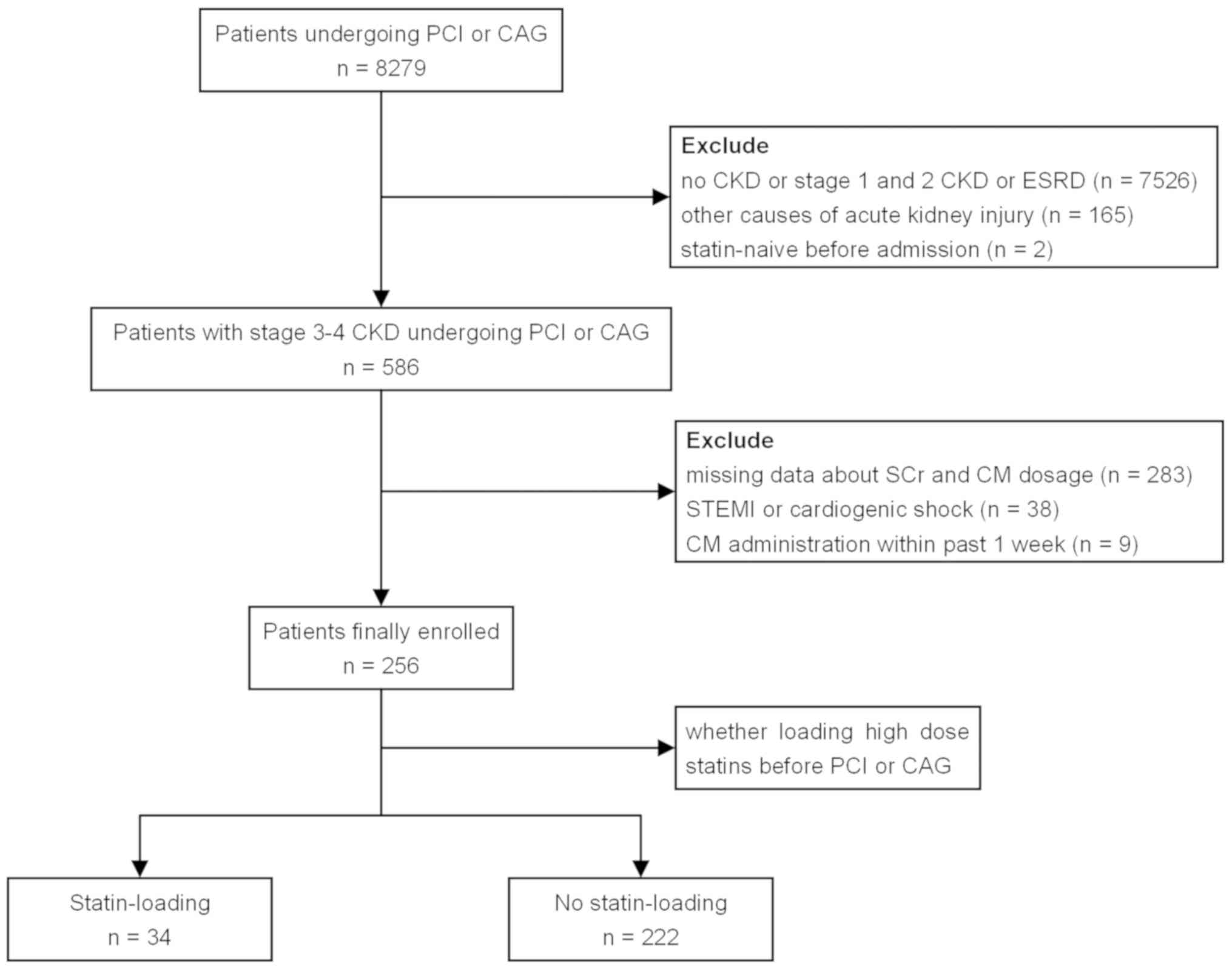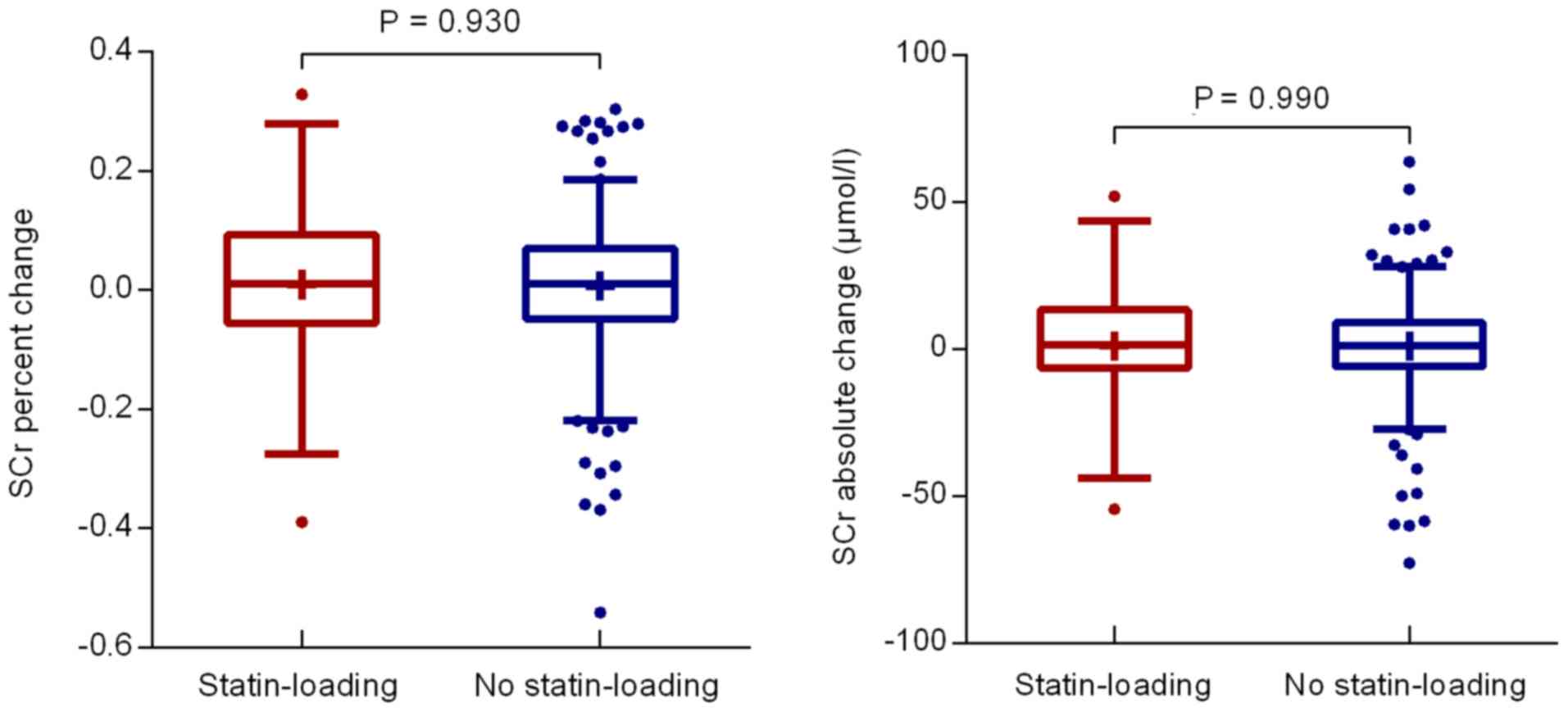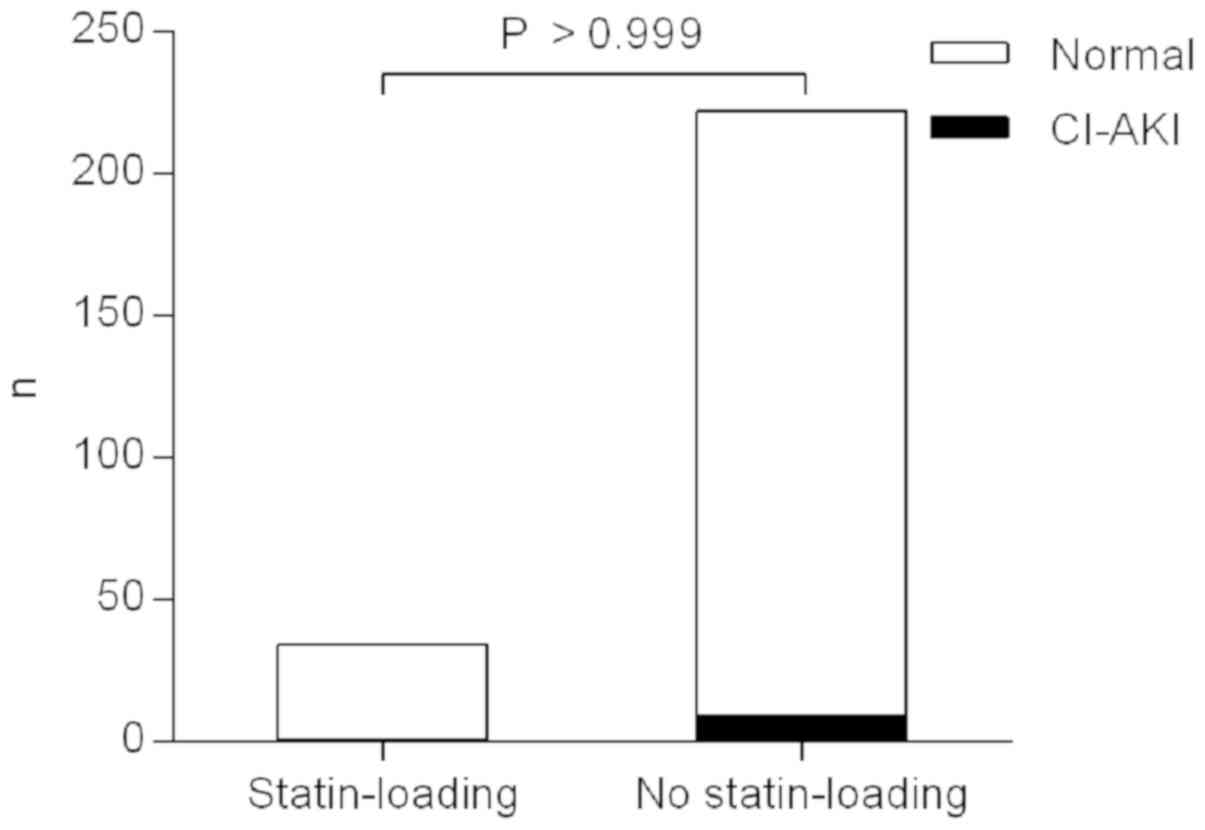|
1
|
Nash K, Hafeez A and Hou S:
Hospital-acquired renal insufficiency. Am J Kidney Dis. 39:930–936.
2002. View Article : Google Scholar : PubMed/NCBI
|
|
2
|
McCullough PA, Adam A, Becker CR, Davidson
C, Lameire N, Stacul F and Tumlin J; CIN Consensus Working Panel, :
Epidemiology and prognostic implications of contrast-induced
nephropathy. Am J Cardiol. 98:5K–13K. 2006. View Article : Google Scholar : PubMed/NCBI
|
|
3
|
Owen RJ, Hiremath S, Myers A, Fraser-Hill
M and Barrett BJ: Canadian Association of Radiologists consensus
guidelines for the prevention of contrast-induced nephropathy:
Update 2012. Can Assoc Radiol J. 65:96–105. 2014. View Article : Google Scholar : PubMed/NCBI
|
|
4
|
Tsai TT, Patel UD, Chang TI, Kennedy KF,
Masoudi FA, Matheny ME, Kosiborod M, Amin AP, Messenger JC,
Rumsfeld JS and Spertus JA: Contemporary incidence, predictors, and
outcomes of acute kidney injury in patients undergoing percutaneous
coronary interventions: Insights from the NCDR Cath-PCI registry.
JACC Cardiovasc Interv. 7:1–9. 2014. View Article : Google Scholar : PubMed/NCBI
|
|
5
|
Gruberg L, Mehran R, Dangas G, Mintz GS,
Waksman R, Kent KM, Pichard AD, Satler LF, Wu H and Leon MB: Acute
renal failure requiring dialysis after percutaneous coronary
interventions. Catheter Cardiovasc Interv. 52:409–416. 2001.
View Article : Google Scholar : PubMed/NCBI
|
|
6
|
Maioli M, Toso A, Leoncini M, Gallopin M,
Musilli N and Bellandi F: Persistent renal damage after
contrast-induced acute kidney injury: Incidence, evolution, risk
factors and prognosis. Circulation. 125:3099–3107. 2012. View Article : Google Scholar : PubMed/NCBI
|
|
7
|
Azzalini L, Spagnoli V and Ly HQ:
Contrast-induced nephropathy: From pathophysiology to preventive
strategies. Can J Cardiol. 32:247–255. 2016. View Article : Google Scholar : PubMed/NCBI
|
|
8
|
Rikitake Y, Kawashima S, Takeshita S,
Yamashita T, Azumi H, Yasuhara M, Nishi H, Inoue N and Yokoyama M:
Anti-oxidative properties of fluvastatin, an HMG-CoA reductase
inhibitor, contribute to prevention of atherosclerosis in
cholesterol-fed rabbits. Atherosclerosis. 154:87–96. 2001.
View Article : Google Scholar : PubMed/NCBI
|
|
9
|
Bonetti PO, Lerman LO, Napoli C and Lerman
A: Statin effects beyond lipid lowering-are they clinically
relevant? Eur Heart J. 24:225–248. 2003. View Article : Google Scholar : PubMed/NCBI
|
|
10
|
Chello M, Goffredo C, Patti G, Candura D,
Melfi R, Mastrobuoni S, Di Sciascio G and Covino E: Effects of
atorvastatin on arterial endothelial function in coronary bypass
surgery. Eur J Cardiothorac Surg. 28:805–810. 2005. View Article : Google Scholar : PubMed/NCBI
|
|
11
|
Almuti K, Rimawi R, Spevack D and Ostfeld
RJ: Effects of statins beyond lipid lowering: Potential for
clinical benefits. Int J Cardiol. 109:7–15. 2006. View Article : Google Scholar : PubMed/NCBI
|
|
12
|
Quintavalle C, Fiore D, De Micco F,
Visconti G, Focaccio A, Golia B, Ricciardelli B, Donnarumma E,
Bianco A, Zabatta MA, et al: Impact of a high loading dose of
atorvastatin on contrast-induced acute kidney injury. Circulation.
126:3008–3016. 2012. View Article : Google Scholar : PubMed/NCBI
|
|
13
|
McCullough PA, Khambatta S and Jazrawi A:
Minimizing the renal toxicity of iodinated contrast. Circulation.
124:1210–1211. 2011. View Article : Google Scholar : PubMed/NCBI
|
|
14
|
Shehata M and Hamza M: Impact of high
loading dose of atorvastatin in diabetic patients with renal
dysfunction undergoing elective percutaneous coronary intervention:
A randomized controlled trial. Cardiovasc Ther. 33:35–41. 2015.
View Article : Google Scholar : PubMed/NCBI
|
|
15
|
Han Y, Zhu G, Han L, Hou F, Huang W, Liu
H, Gan J, Jiang T, Li X, Wang W, et al: Short-term rosuvastatin
therapy for prevention of contrast-induced acute kidney injury in
patients with diabetes and chronic kidney disease. J Am Coll
Cardiol. 63:62–70. 2014. View Article : Google Scholar : PubMed/NCBI
|
|
16
|
Leoncini M, Toso A, Maioli M, Tropeano F,
Villani S and Bellandi F: Early high-dose rosuvastatin for
contrast-induced nephropathy prevention in acute coronary syndrome:
Results from the PRATO-ACS Study (Protective Effect of Rosuvastatin
and Antiplatelet Therapy On contrast-induced acute kidney injury
and myocardial damage in patients with Acute Coronary Syndrome). J
Am Coll Cardiol. 63:71–79. 2014. View Article : Google Scholar : PubMed/NCBI
|
|
17
|
Patti G, Ricottini E, Nusca A, Colonna G,
Pasceri V, D'Ambrosio A, Montinaro A and Di Sciascio G: Short-term,
high-dose Atorvastatin pretreatment to prevent contrast-induced
nephropathy in patients with acute coronary syndromes undergoing
percutaneous coronary intervention (from the ARMYDA-CIN
[atorvastatin for reduction of myocardial damage during
angioplasty-contrast-induced nephropathy] trial. Am J Cardiol.
108:1–7. 2011. View Article : Google Scholar : PubMed/NCBI
|
|
18
|
Ozhan H, Erden I, Ordu S, Aydin M, Caglar
O, Basar C, Yalcin S and Alemdar R: Efficacy of short-term
high-dose atorvastatin for prevention of contrast-induced
nephropathy in patients undergoing coronary angiography. Angiology.
61:711–714. 2010. View Article : Google Scholar : PubMed/NCBI
|
|
19
|
Acikel S, Muderrisoglu H, Yildirir A,
Aydinalp A, Sade E, Bayraktar N, Bal U and Ozin B: Prevention of
contrast-induced impairment of renal function by short-term or
long-term statin therapy in patients undergoing elective coronary
angiography. Blood Coagul Fibrinolysis. 21:750–757. 2010.PubMed/NCBI
|
|
20
|
Su X, Xie X, Liu L, Lv J, Song F, Perkovic
V and Zhang H: Comparative effectiveness of 12 treatment strategies
for preventing contrast-induced acute kidney injury: A systematic
review and bayesian network meta-analysis. Am J Kidney Dis.
69:69–77. 2017. View Article : Google Scholar : PubMed/NCBI
|
|
21
|
Levey AS, Stevens LA, Schmid CH, Zhang YL,
Castro AF III, Feldman HI, Kusek JW, Eggers P, Van Lente F, Greene
T, et al: A new equation to estimate glomerular filtration rate.
Ann Intern Med. 150:604–612. 2009. View Article : Google Scholar : PubMed/NCBI
|
|
22
|
National Kidney Foundation: K/DOQI
clinical practice guidelines for chronic kidney disease:
Evaluation, classification, and stratification. Am J Kidney Dis. 39
(Suppl 1):S1–S266. 2002.PubMed/NCBI
|
|
23
|
Stacul F, van der Molen AJ, Reimer P, Webb
JA, Thomsen HS, Morcos SK, Almén T, Aspelin P, Bellin MF, Clement
O, et al: Contrast induced nephropathy: Updated ESUR Contrast Media
Safety Committee guidelines. Eur Radiol. 21:2527–2541. 2011.
View Article : Google Scholar : PubMed/NCBI
|
|
24
|
Briguori C, Manganelli F, Scarpato P, Elia
PP, Golia B, Riviezzo G, Lepore S, Librera M, Villari B, Colombo A
and Ricciardelli B: Acetylcysteine and contrast agent-associated
nephrotoxicity. J Am Coll Cardiol. 40:298–303. 2002. View Article : Google Scholar : PubMed/NCBI
|
|
25
|
Horn PS, Feng L, Li Y and Pesce AJ: Effect
of outliers and nonhealthy individuals on reference interval
estimation. Clin Chem. 47:2137–2145. 2001.PubMed/NCBI
|
|
26
|
Jo SH, Hahn JY, Lee SY, Kim HJ, Song YB,
Choi JH, Choi SH, Lee SH and Gwon HC: High-dose atorvastatin for
preventing contrast-induced nephropathy in primary percutaneous
coronary intervention. J Cardiovasc Med (Hagerstown). 16:213–219.
2015. View Article : Google Scholar : PubMed/NCBI
|
|
27
|
Abaci O, Arat Ozkan A, Kocas C, Cetinkal
G, Sukru Karaca O, Baydar O, Kaya A and Gurmen T: Impact of
rosuvastatin on contrast-induced acute kidney injury in patients at
high risk for nephropathy undergoing elective angiography. Am J
Cardiol. 115:867–871. 2015. View Article : Google Scholar : PubMed/NCBI
|
|
28
|
Galal H, Nammas W and Samir A: Impact of
high dose versus low dose atorvastatin on contrast induced
nephropathy in diabetic patients with acute coronary syndrome
undergoing early percutaneous coronary intervention. Egypt Heart J.
67:329–336. 2015. View Article : Google Scholar
|
|
29
|
Bidram P, Roghani F, Sanei H, Hedayati Z,
Golabchi A, Mousavi M, Hajiannejad A, Pourheidar B, Badalabadi MM,
Gharaati M, et al: Atorvastatin and prevention of contrast induced
nephropathy following coronary angiography. J Res Med Sci. 20:1–6.
2015.PubMed/NCBI
|
|
30
|
Rear R, Bell RM and Hausenloy DJ:
Contrast-induced nephropathy following angiography and cardiac
interventions. Heart. 102:638–648. 2016. View Article : Google Scholar : PubMed/NCBI
|
|
31
|
Attallah N, Yassine L, Musial J, Yee J and
Fisher K: The potential role of statins in contrast nephropathy.
Clin Nephrol. 62:273–278. 2004. View
Article : Google Scholar : PubMed/NCBI
|
|
32
|
Khanal S, Attallah N, Smith DE,
Kline-Rogers E, Share D, O'Donnell MJ and Moscucci M: Statin
therapy reduces contrast-induced nephropathy: An analysis of
contemporary percutaneous interventions. Am J Med. 118:843–849.
2005. View Article : Google Scholar : PubMed/NCBI
|
|
33
|
Patti G, Nusca A, Chello M, Pasceri V,
D'Ambrosio A, Vetrovec GW and Di Sciascio G: Usefulness of statin
pretreatment to prevent contrast-induced nephropathy and to improve
long-term outcome in patients undergoing percutaneous coronary
intervention. Am J Cardiol. 101:279–285. 2008. View Article : Google Scholar : PubMed/NCBI
|
|
34
|
Yoshida S, Kamihata H, Nakamura S, Senoo
T, Manabe K, Motohiro M, Sugiura T and Iwasaka T: Prevention of
contrast-induced nephropathy by chronic pravastatin treatment in
patients with cardiovascular disease and renal insufficiency. J
Cardiol. 54:192–198. 2009. View Article : Google Scholar : PubMed/NCBI
|
|
35
|
Jo SH, Koo BK, Park JS, Kang HJ, Cho YS,
Kim YJ, Youn TJ, Chung WY, Chae IH, Choi DJ, et al: Prevention of
radiocontrast medium-induced nephropathy using short-term high-dose
simvastatin in patients with renal insufficiency undergoing
coronary angiography (PROMISS) trial-a randomized controlled study.
Am Heart J. 155:499 e1–e8. 2008. View Article : Google Scholar
|
|
36
|
Toso A, Maioli M, Leoncini M, Gallopin M,
Tedeschi D, Micheletti C, Manzone C, Amato M and Bellandi F:
Usefulness of atorvastatin (80 mg) in prevention of
contrast-induced nephropathy in patients with chronic renal
disease. Am J Cardiol. 105:288–292. 2010. View Article : Google Scholar : PubMed/NCBI
|
|
37
|
Hall WD: Abnormalities of kidney function
as a cause and a consequence of cardiovascular disease. Am J Med
Sci. 317:176–182. 1999. View Article : Google Scholar : PubMed/NCBI
|
|
38
|
Hou W, Lv J, Perkovic V, Yang L, Zhao N,
Jardine MJ, Cass A, Zhang H and Wang H: Effect of statin therapy on
cardiovascular and renal outcomes in patients with chronic kidney
disease: A systematic review and meta-analysis. Eur Heart J.
34:1807–1817. 2013. View Article : Google Scholar : PubMed/NCBI
|
|
39
|
Latif F, Kleiman NS, Cohen DJ, Pencina MJ,
Yen CH, Cutlip DE, Moliterno DJ, Nassif D, Lopez JJ and Saucedo JF;
EVENT Investigators, : In-hospital and 1-year outcomes among
percutaneous coronary intervention patients with chronic kidney
disease in the era of drug-eluting stents: A report from the EVENT
(Evaluation of Drug Eluting Stents and Ischemic Events) registry.
JACC Cardiovasc Interv. 2:37–45. 2009. View Article : Google Scholar : PubMed/NCBI
|
|
40
|
Natsuaki M, Furukawa Y, Morimoto T, Sakata
R and Kimura T; CREDO-Kyoto PCI/CABG Registry Cohort-2
Investigators, : Renal function and effect of statin therapy on
cardiovascular outcomes in patients undergoing coronary
revascularization (from the CREDO-Kyoto PCI/CABG Registry
Cohort-2). Am J Cardiol. 110:1568–1577. 2012. View Article : Google Scholar : PubMed/NCBI
|
|
41
|
Dasari TW, Cohen DJ, Kleiman NS, Keyes MJ,
Yen CH, Hanna EB and Saucedo JF: Statin therapy in patients with
chronic kidney disease undergoing percutaneous coronary
intervention (from the Evaluation of Drug Eluting Stents and
Ischemic Events Registry). Am J Cardiol. 113:621–625. 2014.
View Article : Google Scholar : PubMed/NCBI
|
|
42
|
Stone NJ, Robinson JG, Lichtenstein AH,
Bairey Merz CN, Blum CB, Eckel RH, Goldberg AC, Gordon D, Levy D,
Lloyd-Jones DM, et al: 2013 ACC/AHA guideline on the treatment of
blood cholesterol to reduce atherosclerotic cardiovascular risk in
adults: A report of the American College of Cardiology/American
Heart Association Task Force on Practice Guidelines. J Am Coll
Cardiol. 63:2889–2934. 2014. View Article : Google Scholar : PubMed/NCBI
|
|
43
|
Downs JR and O'Malley PG: Management of
dyslipidemia for cardiovascular disease risk reduction: Synopsis of
the 2014 U.S. Department of Veterans Affairs and U.S. Department of
Defense clinical practice guideline. Ann Intern Med. 163:291–297.
2015. View Article : Google Scholar : PubMed/NCBI
|
|
44
|
Jacobson TA, Ito MK, Maki KC, Orringer CE,
Bays HE, Jones PH, McKenney JM, Grundy SM, Gill EA, Wild RA, et al:
National Lipid Association recommendations for patient-centered
management of dyslipidemia: Part 1-executive summary. J Clin
Lipidol. 8:473–488. 2014. View Article : Google Scholar : PubMed/NCBI
|
|
45
|
Catapano AL, Graham I, De Backer G,
Wiklund O, Chapman MJ, Drexel H, Hoes AW, Jennings CS, Landmesser
U, Pedersen TR, et al: 2016 ESC/EAS guidelines for the management
of dyslipidaemias. Eur Heart J. 37:2999–3058. 2016. View Article : Google Scholar : PubMed/NCBI
|
|
46
|
McCullough PA, Choi JP, Feghali GA,
Schussler JM, Stoler RM, Vallabahn RC and Mehta A: Contrast-induced
acute kidney injury. J Am Coll Cardiol. 68:1465–1473. 2016.
View Article : Google Scholar : PubMed/NCBI
|
|
47
|
Levine GN, Bates ER, Blankenship JC,
Bailey SR, Bittl JA, Cercek B, Chambers CE, Ellis SG, Guyton RA,
Hollenberg SM, et al: 2011 ACCF/AHA/SCAI Guideline for Percutaneous
Coronary Intervention: Executive summary: A report of the American
College of Cardiology Foundation/American Heart Association Task
Force on Practice Guidelines and the Society for Cardiovascular
Angiography and Interventions. Circulation. 124:2574–2609. 2011.
View Article : Google Scholar : PubMed/NCBI
|
|
48
|
Kolh P, Windecker S, Alfonso F, Collet JP,
Cremer J, Falk V, Filippatos G, Hamm C, Head SJ, Jüni P, et al:
2014 ESC/EACTS Guidelines on myocardial revascularization: The Task
Force on Myocardial Revascularization of the European Society of
Cardiology (ESC) and the European Association for Cardio-Thoracic
Surgery (EACTS). Developed with the special contribution of the
European Association of Percutaneous Cardiovascular Interventions
(EAPCI). Eur J Cardiothorac Surg. 46:517–592. 2014. View Article : Google Scholar : PubMed/NCBI
|
|
49
|
Guitterez NV, Diaz A, Timmis GC, O'Neill
WW, Stevens MA, Sandberg KR and McCullough PA: Determinants of
serum creatinine trajectory in acute contrast nephropathy. J Interv
Cardiol. 15:349–354. 2002. View Article : Google Scholar : PubMed/NCBI
|
|
50
|
Briguori C, Visconti G, Rivera NV,
Focaccio A, Golia B, Giannone R, Castaldo D, De Micco F,
Ricciardelli B and Colombo A: Cystatin C and contrast-induced acute
kidney injury. Circulation. 121:2117–2122. 2010. View Article : Google Scholar : PubMed/NCBI
|

















